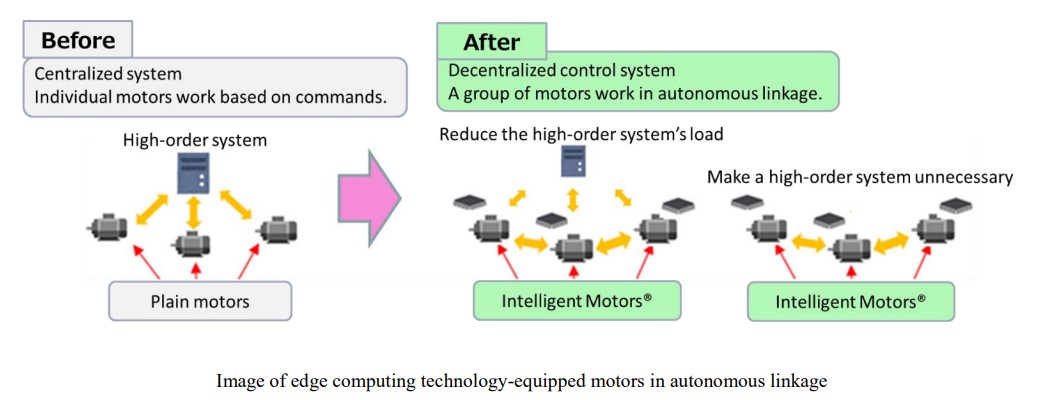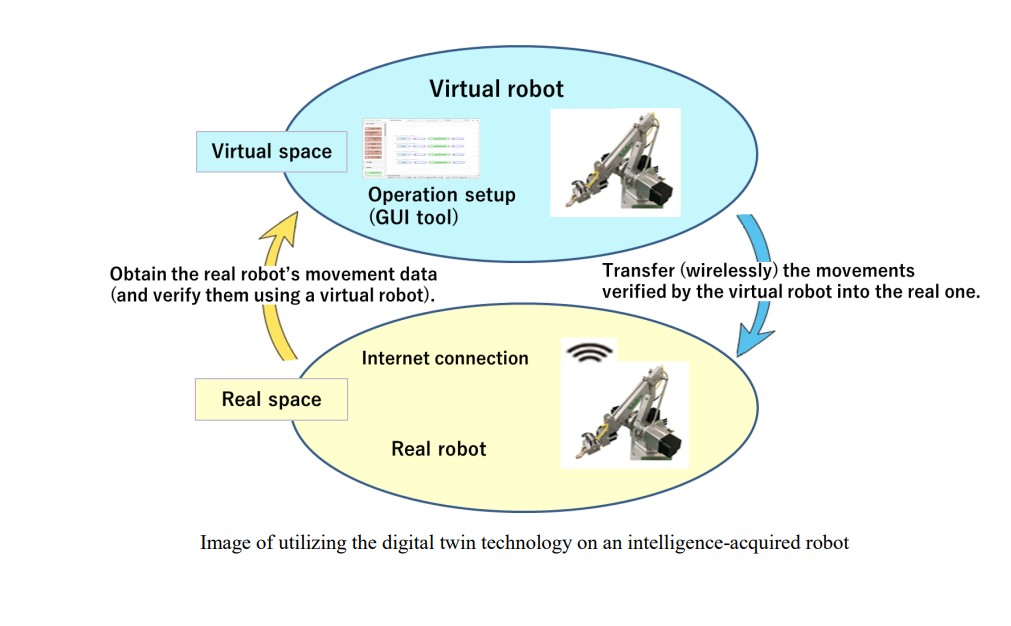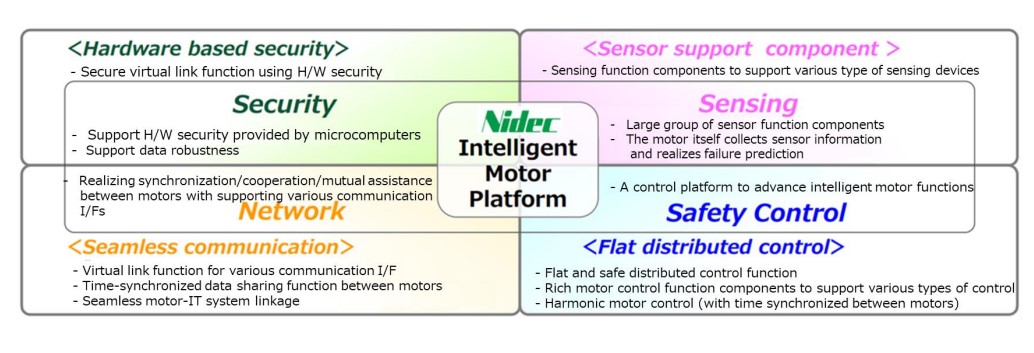- Contact:
- Masahiro Nagayasu
- General Manager
- Investor Relations
- +81-75-935-6140
- ir@nidec.com
Released on June 26, 2023, in Kyoto, Japan
Nidec Corporation (TSE: 6594; OTC US: NJDCY) (“Nidec” or the “Company”) today announced that it has developed a proof of concept (PoC) to realize an “Intelligent Motor® solution,” a system that the Company defined to adapt (i) Intelligent Motors®*1 , which are equipped with microcomputers and data coupling and time synchronization functions, and (ii) products with an Intelligent Motor®, to digital twin*2 .
As DX and ICT (Information and Communication Technology) become a mainstream of the time to serve as solutions for labor shortage-stricken production sites(that are struggling with factory launch, education, supervising, maintenance work, etc.), Nidec has successfully created the following three solutions that comprise the technical features of Intelligent Motor® solutions for such issues:
- 1. A system to reproduce issues from reality in a virtual space and conduct a test (cloud technology);
- 2.A system where even those not experts in 1 above can reproduce such issues in a virtual space (GUI technology); and
- 3.A system to incorporate edge computing into a motor, and bring it to the IoT market.
In verifying the aforementioned concept, Nidec selected a triaxial parallel link robot*3 as our theme this time, after anticipating proposing Intelligent Motor® solutions to robot manufacturers. With intelligence-equipped motors operating in collaboration with one another and with high accuracy, the Company succeeded in operating a robot without the use of a central control unit, while reproducing the robot’s virtual counterpart in a virtual space. Thus, using GUI fully, Nidec designed and verified the virtual robot’s operation program, and developed a next-generation development environment that reflects the operating program in the robot in the actual space via wireless communications, to verify the above functional operations (For more details on the background of this development and technical features, please see the “Reference” section on Page 2 and after of this press release).
The above technology can: (i) reduce, or even eliminate, the load on motor-assembled equipment’s central control unit; and (ii) verify any changes to the system – ranging from changes to a motor’s application to issues that occurred in the workplace – in a cloud-based virtual space, and implement those changes in the actual space in real time. Hence, the technology will likely serve as a solution for labor shortage at factories around the world by creating a digital twin world easily.
Nidec is poised to provide this Intelligent Motor® solution to enhance the additional values of motors in the world, and create a more affluent society.
*1. Intelligent Motor®: A Nidec-developed motor with a built-in compact computer. The motor’s user can control the motor easily with a wireless network, and obtain location, speed, torque, and various other information on the motor. Intelligent Motor is a registered trademark of Nidec Corporation.
*2. Digital twin: A system to, based on real-time information gathering and analysis, reproduce an actual environment in a virtual space.
*3 PoC (Proof of Concept): Advance verification of the feasibility of a new idea or concept, and its effects among others.
*4. This press release, which features a product that realizes digital twin as an example, is not intended to develop or sell any robot itself.
Reference
Background Information
A majority of small brushless DC motors use an IC dedicated to controlling them. This IC, while inexpensive, needed to be redesigned when changing its control function. With the use of a microcomputer in place of a dedicated IC to control the motor with software, the user can revise the control functions on the program without changing the IC’s design, while enjoying serial communications with a high-order system.
The rate of microcomputers in small brushless DC motors has doubled in four years from 2018 – 2022 (results based on Nidec’s internal research), and the number is expected to rise further going forward. Here, microcomputers are to drive motors that they are installed with; likewise, those microcomputer-equipped motors are to function based on commands from a high-order system.

Nidec’s Intelligent Motor® solutions, which incorporate edge computing into a microcomputer-equipped motor, does not require any command from a high-order system: The motor creates its own operating environment, or an environment where multiple motors utilize communication functions with each other to work in concert, to either reduce the load on their high-order system, or eliminate it altogether. Thus, the user can expect reduction in cost, data traffic, and wiring among others.

In addition, after the pandemic made travelling and moving difficult, and solving issues at workplaces (e.g., factory launch, education, monitoring, and maintenance) became an urgent task, DX and ICT (Information and Communication Technology) became a mainstream of the time as solutions for them.
Playing a pivotal role in addressing those issues is digital twin, which reproduce an environment in an actual place, in a virtual one. In addition to the aforementioned technology to incorporate edge computing functions in a motor, Nidec developed a system to solve issues from an actual space in a virtual one (cloud technology) and a system where anyone one, even those not experts in the area can solve issues that way (GUI technology), successfully adapting to digital twin, the technology that reproduces the operating environment of an Intelligent Motor®-equipped product in a virtual space.

The New Technology’s Features
1. Software platform for Intelligent Motor®
By combining its motor control technology with Connected PLC, a software technology owned by International Laboratory Corporation*5 , Nidec developed a software platform for Intelligent Motor®, which provides basic functions for Intelligent Motor-based equipment, devices, system development, and DX.

By utilizing the above software platform, Nidec creates the high-value-added motors in Section 2 – 4 above, strongly supporting productivity improvement via, among others, reduction of man-hours for our motor customers’ product and system development, prompt troubleshooting, and failure prognosis during operation.
2. Connected motor
- Establish a seamless connection between motors and between a motor and a device via encrypted secure communication.
- Perform, among others, time-synchronized inter-motor control and data sharing, and complementing and linkage based on the operating conditions between motors.
3. Self-programmable motor
- Use GUI to intuitively create and fix an application program that works on a motor, to enable the user to develop motors, devices, and systems based on individual applications.
- Utilize Nidec-provided software function components to enable easy motor application and system development, and function changes and enhancements, and significantly reduce development man-hours.
4. Virtual Intelligent Motor
- Use a virtualized motor that operates on a virtual cloud, to utilize next-generation development methods and environments (e.g. digital twin) in motor, device, and system development.
- Utilize new cloud-based services (e.g., remote diagnosis, defect prognosis, and device management).
By utilizing our Intelligent Motor® and Intelligent Motor® software platform, Nidec can simply combine motors to create a variety of products that operate without a high-order system, and make them work with the digital twin system. Hence, when a motor’s usage is changed, or if an issue occurs at a workplace, the user can verify the system change in a cloudbased virtual space, and revise the system real-time in the actual space.
*5. International Laboratory Corporation
Head Office: Chiyoda-ku, Tokyo
Representative: Mr. Eisaku Onishi (Representative Director, Chairman and CEO)
Website:
http://www.ilc.co.jp/commodity/connectedplc/index.html

